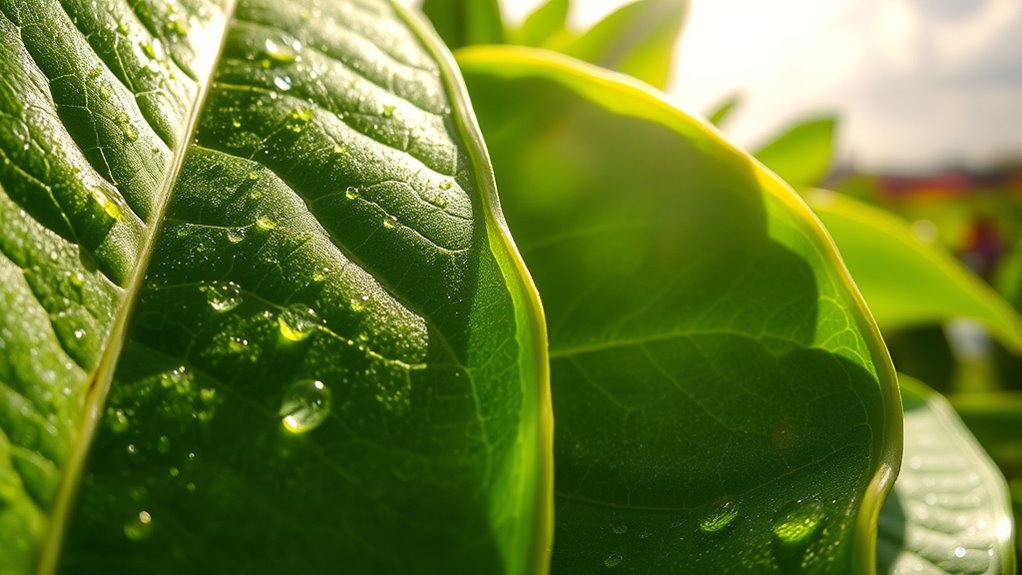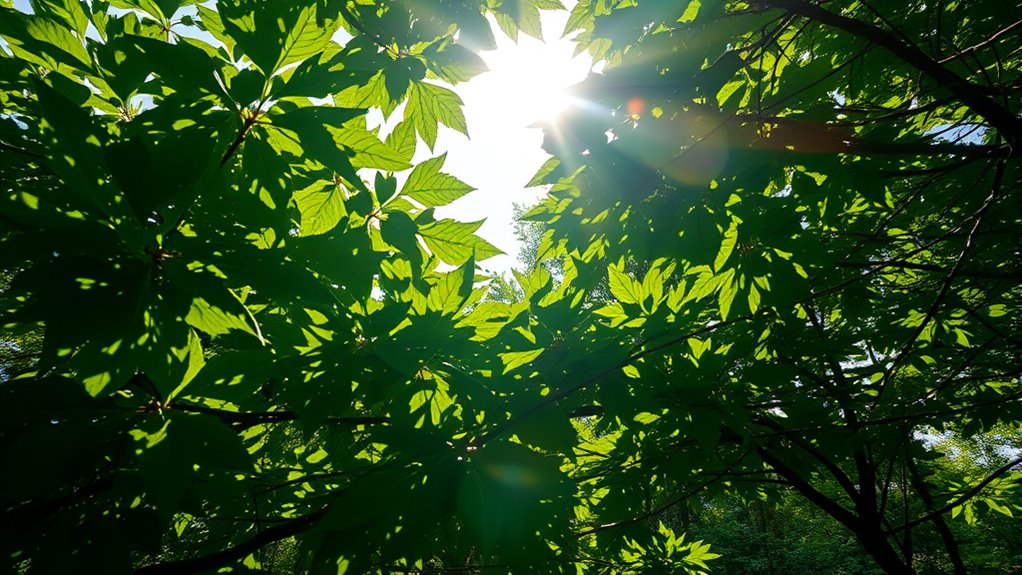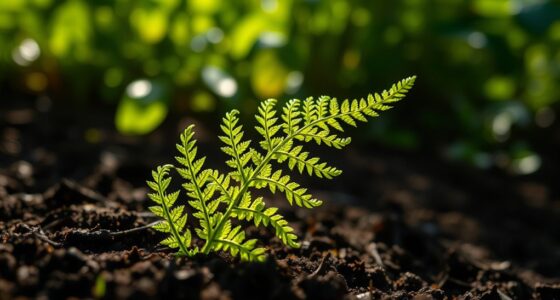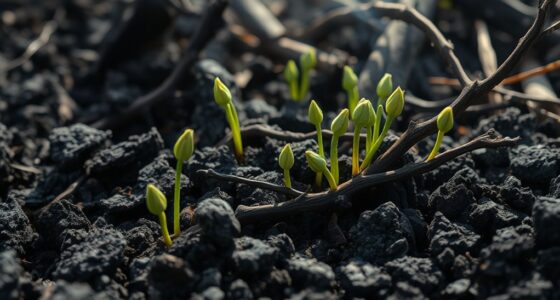Hot days and warm nights can push your plants’ photosynthesis close to its limits, mainly by causing stomata to stay closed longer to conserve water. This reduces CO₂ intake, slows enzyme activity, and hampers the plant’s ability to produce sugars, which affects growth and yield. Over time, these conditions lead to chronic stress, making your plants less efficient and more vulnerable. Keep exploring to learn how plants battle these heat challenges and ways to support them.
Key Takeaways
- Hot days cause stomatal closure, reducing CO2 entry and lowering photosynthetic rates.
- Warm nights can impair enzymatic activities crucial for carbon fixation in photosynthesis.
- Elevated temperatures decrease enzyme efficiency, limiting internal CO2 processing.
- Prolonged heat stresses lead to sustained reductions in photosynthetic productivity.
- Species vary in heat tolerance, affecting their capacity to maintain CO2 uptake during hot conditions.

Hot days and warm nights can considerably influence the process of photosynthesis in plants. When temperatures rise beyond certain limits, your plants reach their temperature thresholds, which can hinder their ability to efficiently convert sunlight into energy. As temperatures climb, the delicate balance of photosynthesis gets disrupted, and you may notice a decline in CO2 uptake. This happens because high heat can cause plants to close their stomata—the tiny pores on leaves responsible for gas exchange—to conserve water. While this stomatal regulation is essential for preventing dehydration, it also limits the entry of CO2, directly reducing the rate of photosynthesis.
During extreme heat, your plants’ stomata tend to stay closed longer, even during daylight hours, when they should be open to absorb CO2. This adaptive response, although indispensable for water conservation, becomes a double-edged sword. The reduced stomatal aperture means less CO2 enters the leaf, which directly impacts the photosynthetic process. As a result, your plants may struggle to produce enough sugars, leading to slower growth and decreased productivity. If the heat persists, this suppression can become chronic, affecting overall plant health and yield.
Heat stress causes plants to keep stomata closed, reducing CO2 intake and hindering photosynthesis.
Moreover, temperature thresholds are not uniform across different plant species. Some plants are more heat-tolerant and can maintain stomatal opening longer under high temperatures, but many others are more sensitive. When temperatures surpass the ideal range, enzymatic activities involved in photosynthesis slow down, further diminishing CO2 fixation. As a result, even if stomata remain open, the internal biochemical processes become less efficient. This combination of stomatal closure and enzymatic slowdown can severely limit your plant’s ability to photosynthesize effectively during hot days and warm nights.
If the heat stays intense over extended periods, your plants might also experience stress responses that further compromise their photosynthetic capacity. They may produce protective compounds or alter their leaf structure, but these adaptations can divert energy from growth and reproduction. Managing this stress involves understanding the essential role of stomatal regulation and recognizing when temperatures exceed your plants’ thresholds. You can help mitigate these effects through proper watering, shading, or selecting heat-tolerant species, but ultimately, high temperatures challenge the very core of photosynthetic efficiency.
Frequently Asked Questions
How Do Different Plant Species Vary in Their Response to Temperature Stress?
You’ll notice that different plant species vary in their response to temperature stress, mainly due to their species resilience and metabolic flexibility. Some plants adapt better, maintaining photosynthesis and growth during heat, while others struggle and reduce CO2 uptake. Your understanding of these differences helps in selecting resilient species for changing climates, ensuring better survival and productivity despite temperature extremes.
What Are the Long-Term Ecological Impacts of Increased Hot Days and Warm Nights?
You’ll see significant long-term ecological impacts from more hot days and warm nights. As temperatures rise, ecosystem shifts occur, altering habitats and species distributions. This can lead to biodiversity loss, with some plants and animals unable to adapt quickly enough. These changes disrupt food webs and ecosystem services, ultimately affecting the health and stability of the environment you rely on. Prepare for a future of dynamic, but fragile, ecological balances.
Can Plants Adapt Quickly Enough to Changing Temperature Patterns?
Did you know that plants can sometimes adjust their physiology in just a few days? When faced with changing temperatures, you might wonder if they can keep up. While thermal acclimation allows some quick adjustments, genetic adaptation takes much longer. So, in the short term, plants often rely on thermal acclimation, but for lasting change, they depend on slower genetic adaptation. You’ll see their responses vary based on these processes.
How Do Temperature Changes Affect Other Plant Physiological Processes?
You notice that temperature changes influence plant physiology markedly. Warmer days prompt you to observe stomatal regulation, where your plants might close their stomata to conserve water, reducing CO2 intake. Additionally, enzyme activity speeds up with moderate warmth, boosting processes like respiration. However, extreme heat can hinder enzyme functions, impairing growth and development. By understanding these responses, you can better manage your plants under varying temperature conditions.
What Role Do Soil Conditions Play in Plants’ Temperature Resilience?
Imagine soil as a plant’s secret shield against heat. You play a essential role by maintaining proper soil moisture, which keeps roots healthy and helps plants withstand temperature stress. When roots are strong and soil stays moist, plants are better equipped to endure hot days and warm nights. Your mindful watering and soil care boost resilience, turning the earth into a fortress that shields your plants from temperature extremes.
Conclusion
As you observe the subtle dance of nature, it’s clear that hot days and warm nights gently influence how plants breathe in CO₂. While these conditions may nudge photosynthesis to new limits, they also remind you of nature’s delicate balance. Embrace the quiet shifts, knowing they reveal the resilience and fragility of life’s green heart. In this gentle dance, every change whispers a story of adaptation and hope for what’s to come.










